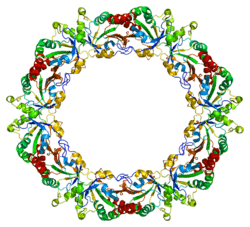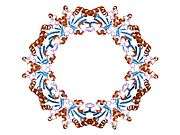PRDX3
Thioredoxin-dependent peroxide reductase, mitochondrial is an enzyme that in humans is encoded by the PRDX3 gene.[5][6][7] It is a member of the peroxiredoxin family of antioxidant enzymes.
Function
This gene encodes a protein with antioxidant function and is localized in the mitochondrion. This gene shows significant nucleotide sequence similarity to the gene coding for the C22 subunit of Salmonella typhimurium alkylhydroperoxide reductase. Expression of this gene product in E. coli deficient in the C22-subunit gene rescued resistance of the bacteria to alkylhydroperoxide. The human and mouse genes are highly conserved, and they map to the regions syntenic between mouse and human chromosomes. Sequence comparisons with recently cloned mammalian homologues suggest that these genes consist of a family that is responsible for regulation of cellular proliferation, differentiation, and antioxidant functions. Two transcript variants encoding two different isoforms have been found for this gene.[7]
Interactions
Clinical significance
It has been demonstrated that serum peroxiredoxin 3 can be a valuable biomarker for the diagnosis and assessment of hepatocellular carcinoma[9] It has been shown that peroxiredoxin proteins protect MCF-7 breast cancer cells against doxorubicin-mediated toxicity.[10] Additionally, it has been shown that peroxiredoxin 3 is overexpressed in prostate cancer and promotes cancer cell survival by defending cells against the damages incurred by oxidative stress.[11]
References
- 1 2 3 GRCh38: Ensembl release 89: ENSG00000165672 - Ensembl, May 2017
- 1 2 3 GRCm38: Ensembl release 89: ENSMUSG00000024997 - Ensembl, May 2017
- ↑ "Human PubMed Reference:".
- ↑ "Mouse PubMed Reference:".
- ↑ Tsuji K, Copeland NG, Jenkins NA, Obinata M (May 1995). "Mammalian antioxidant protein complements alkylhydroperoxide reductase (ahpC) mutation in Escherichia coli". Biochem. J. 307 (2): 377–81. doi:10.1042/bj3070377. PMC 1136659. PMID 7733872.
- ↑ Watabe S, Hiroi T, Yamamoto Y, Fujioka Y, Hasegawa H, Yago N, Takahashi SY (Dec 1997). "SP-22 is a thioredoxin-dependent peroxide reductase in mitochondria". Eur. J. Biochem. 249 (1): 52–60. doi:10.1111/j.1432-1033.1997.t01-1-00052.x. PMID 9363753.
- 1 2 "Entrez Gene: PRDX3 peroxiredoxin 3".
- ↑ Masaki M, Ikeda A, Shiraki E, Oka S, Kawasaki T (Jan 2003). "Mixed lineage kinase LZK and antioxidant protein-1 activate NF-kappaB synergistically". Eur. J. Biochem. 270 (1): 76–83. doi:10.1046/j.1432-1033.2003.03363.x. PMID 12492477.
- ↑ Shi L, Wu LL, Yang JR, Chen XF, Zhang Y, Chen ZQ, Liu CL, Chi SY, Zheng JY, Huang HX, Yu FJ, Lin XY (2014). "Serum peroxiredoxin3 is a useful biomarker for early diagnosis and assessment of prognosis of hepatocellular carcinoma in Chinese patients". Asian Pacific Journal of Cancer Prevention. 15 (7): 2979–86. doi:10.7314/apjcp.2014.15.7.2979. PMID 24815434.
- ↑ McDonald C, Muhlbauer J, Perlmutter G, Taparra K, Phelan SA (Jul 2014). "Peroxiredoxin proteins protect MCF-7 breast cancer cells from doxorubicin-induced toxicity". International Journal of Oncology. 45 (1): 219–26. doi:10.3892/ijo.2014.2398. PMID 24789097.
- ↑ Whitaker HC, Patel D, Howat WJ, Warren AY, Kay JD, Sangan T, Marioni JC, Mitchell J, Aldridge S, Luxton HJ, Massie C, Lynch AG, Neal DE (Aug 2013). "Peroxiredoxin-3 is overexpressed in prostate cancer and promotes cancer cell survival by protecting cells from oxidative stress". British Journal of Cancer. 109 (4): 983–93. doi:10.1038/bjc.2013.396. PMC 3749568. PMID 23880827.
Further reading
- Hochstrasser DF, Frutiger S, Paquet N, Bairoch A, Ravier F, Pasquali C, Sanchez JC, Tissot JD, Bjellqvist B, Vargas R (1992). "Human liver protein map: a reference database established by microsequencing and gel comparison". Electrophoresis. 13 (12): 992–1001. doi:10.1002/elps.11501301201. PMID 1286669.
- Maruyama K, Sugano S (1994). "Oligo-capping: a simple method to replace the cap structure of eukaryotic mRNAs with oligoribonucleotides". Gene. 138 (1–2): 171–4. doi:10.1016/0378-1119(94)90802-8. PMID 8125298.
- Suzuki Y, Yoshitomo-Nakagawa K, Maruyama K, Suyama A, Sugano S (1997). "Construction and characterization of a full length-enriched and a 5'-end-enriched cDNA library". Gene. 200 (1–2): 149–56. doi:10.1016/S0378-1119(97)00411-3. PMID 9373149.
- Shih SF, Wu YH, Hung CH, Yang HY, Lin JY (2001). "Abrin triggers cell death by inactivating a thiol-specific antioxidant protein". J. Biol. Chem. 276 (24): 21870–7. doi:10.1074/jbc.M100571200. PMID 11285261.
- Suzuki H, Fukunishi Y, Kagawa I, Saito R, Oda H, Endo T, Kondo S, Bono H, Okazaki Y, Hayashizaki Y (2001). "Protein-protein interaction panel using mouse full-length cDNAs". Genome Res. 11 (10): 1758–65. doi:10.1101/gr.180101. PMC 311163. PMID 11591653.
- Kim SH, Fountoulakis M, Cairns N, Lubec G (2001). "Protein levels of human peroxiredoxin subtypes in brains of patients with Alzheimer's disease and Down syndrome". J. Neural Transm. Suppl. (61): 223–35. doi:10.1007/978-3-7091-6262-0_18. PMID 11771746.
- Rabilloud T, Heller M, Gasnier F, Luche S, Rey C, Aebersold R, Benahmed M, Louisot P, Lunardi J (2002). "Proteomics analysis of cellular response to oxidative stress. Evidence for in vivo overoxidation of peroxiredoxins at their active site". J. Biol. Chem. 277 (22): 19396–401. doi:10.1074/jbc.M106585200. PMID 11904290.
- Wonsey DR, Zeller KI, Dang CV (2002). "The c-Myc target gene PRDX3 is required for mitochondrial homeostasis and neoplastic transformation". Proc. Natl. Acad. Sci. U.S.A. 99 (10): 6649–54. doi:10.1073/pnas.102523299. PMC 124457. PMID 12011429.
- Wagner E, Luche S, Penna L, Chevallet M, Van Dorsselaer A, Leize-Wagner E, Rabilloud T (2002). "A method for detection of overoxidation of cysteines: peroxiredoxins are oxidized in vivo at the active-site cysteine during oxidative stress". Biochem. J. 366 (Pt 3): 777–85. doi:10.1042/BJ20020525. PMC 1222825. PMID 12059788.
- Shen C, Nathan C (2002). "Nonredundant antioxidant defense by multiple two-cysteine peroxiredoxins in human prostate cancer cells". Mol. Med. 8 (2): 95–102. PMC 2039972. PMID 12080185.
- Masaki M, Ikeda A, Shiraki E, Oka S, Kawasaki T (2003). "Mixed lineage kinase LZK and antioxidant protein-1 activate NF-kappaB synergistically". Eur. J. Biochem. 270 (1): 76–83. doi:10.1046/j.1432-1033.2003.03363.x. PMID 12492477.
- Choi JH, Kim TN, Kim S, Baek SH, Kim JH, Lee SR, Kim JR (2003). "Overexpression of mitochondrial thioredoxin reductase and peroxiredoxin III in hepatocellular carcinomas". Anticancer Res. 22 (6A): 3331–5. PMID 12530083.
- Krapfenbauer K, Engidawork E, Cairns N, Fountoulakis M, Lubec G (2003). "Aberrant expression of peroxiredoxin subtypes in neurodegenerative disorders". Brain Res. 967 (1–2): 152–60. doi:10.1016/S0006-8993(02)04243-9. PMID 12650976.
- Chang TS, Cho CS, Park S, Yu S, Kang SW, Rhee SG (2004). "Peroxiredoxin III, a mitochondrion-specific peroxidase, regulates apoptotic signaling by mitochondria". J. Biol. Chem. 279 (40): 41975–84. doi:10.1074/jbc.M407707200. PMID 15280382.
- Liu L, Yang C, Yuan J, Chen X, Xu J, Wei Y, Yang J, Lin G, Yu L (2005). "RPK118, a PX domain-containing protein, interacts with peroxiredoxin-3 through pseudo-kinase domains". Mol. Cells. 19 (1): 39–45. PMID 15750338.






